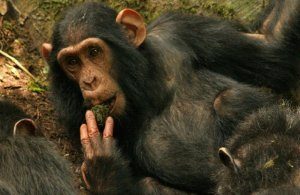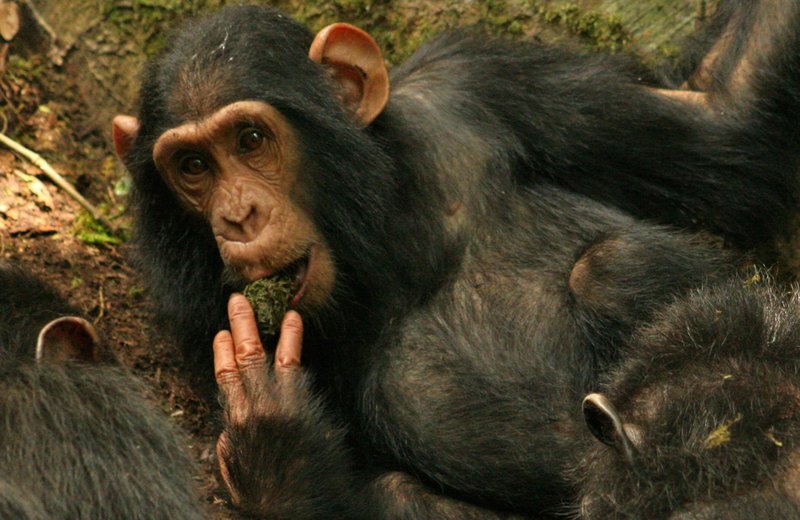
Evidence of new behaviour being adopted and transmitted socially from one individual to another within a wild chimpanzee community was published on September 30 in the open access journal PLOS Biology. This is the first instance of social learning recorded in the wild.
Scientists from the University of St Andrews, University of Neuchâtel, Anglia Ruskin University, and Université du Quebec studied the spread of two novel tool-use behaviours among the Sonso chimpanzee community living in Uganda’s Budongo Forest. Dr Catherine Hobaiter, Lecturer in Psychology at the University of St Andrews, said: “researchers have been fascinated for decades by the differences in behaviour between chimpanzee communities; some use tools, some don’t, some use different tools for the same job. These behavioural variations have been described as ‘cultural’, which in human terms would mean they spread when one individual learns from another; but in most cases they’re long established and it’s hard to know how they originally spread within a group. We were incredibly lucky to be in the right place at the right time to document the appearance and spread of two novel tool-use behaviours, something that is extraordinarily rare in the wild.”
The researchers investigated the spread of new variations of ‘leaf-sponges’, which are tools dipped in water to drink from, commonly manufactured by the Sonso chimpanzees by folding leaves in their mouth. Different individuals were observed to develop two novel variants: moss-sponging (a sponge made of moss or a mixture of leaves and moss) and leaf-sponge re-use (using a sponge left behind on a previous visit). Neither moss-sponging nor leaf-sponge re-use had been previously observed in Sonso in over twenty years of continuous observation. Chimpanzees are widely considered to be the most ‘cultural’ of all non-human animals, but most studies examining how behaviour is transmitted are carried out in captive groups. This has long been a focus for critics of arguments for chimpanzee culture, who point out that without similar evidence from the wild it is difficult to argue for an evolutionary connection between human and chimpanzee ‘culture’. Here, for the first time, researchers tracked in real time how a new natural behaviour was passed from individual to individual in a wild community. Dr William Hoppitt, Senior Lecturer in Zoology at Anglia Ruskin University said: “Our results provide strong evidence for social transmission along the chimpanzees’ social network, demonstrating that wild chimpanzees learn novel tool-use from each other and support the claim that some of the observed behavioural diversity in wild chimpanzees should be interpreted as ‘cultural’.”
The analysis began when Nick, a 29-year-old alpha male chimpanzee, made a moss sponge while being watched by Nambi, a dominant adult female. Over the next six days a further seven individuals made and used moss sponges. Six of these had observed the behaviour before adopting it and the seventh was seen to re-use a discarded moss sponge so may have learned about the novel behaviour in this way. The scientists also recorded a 12-year-old sub-adult male retrieve and use a discarded leaf sponge. A further eight individuals adopted the re-use technique, but only four of them observed another individual re-using a sponge first. By using a technique called network-based diffusion analysis the researchers estimated that each time a ‘naïve’ chimpanzee observed moss-sponging, this individual was 15 times more likely to develop the behaviour. This striking effect contrasted with the re-use behaviour in which social learning played much less of a role.
___________________________________
 This is individual ‘KB’ of the Sonso chimpanzee community of the Budongo Forest in Uganda, using a moss-sponge in November 2011, a behavior she learned by observing her mother. Photo by Catherine Hobaiter
This is individual ‘KB’ of the Sonso chimpanzee community of the Budongo Forest in Uganda, using a moss-sponge in November 2011, a behavior she learned by observing her mother. Photo by Catherine Hobaiter
_____________________________________________
The study indicates that group-specific behavioural variants in wild chimpanzees can be socially learned, adding to the evidence that this prerequisite for culture originated in a common ancestor of great apes and humans, before the advent of humans. Dr Thibaud Gruber, Marie Curie Fellow at the University of Neuchâtel, said: “This study tells us that chimpanzee culture changes over time, little by little, by building on previous knowledge found within the community. This is probably how our early ancestors’ cultures also changed over time. In this respect, this is a great example of how studying chimpanzee culture can help us model the evolution of human culture. Nevertheless, something must have subsequently happened in our evolution that caused a qualitative shift in what we could transmit, rendering our culture much more complex than anything found in wild apes. Understanding this qualitative jump in our evolutionary history is what we need to investigate now.”
Individual KZ (right of the screen) picks a leaf-sponge from the ground while his mother KW is extracting water from the waterhole. He then chews the used LS before leaf-sponging himself at the waterhole (video by Catherine Hobaiter).
___________________________________________
Source: Edited from a press release of PLOS Biology. All works published in PLOS Biology are open access, which means that everything is immediately and freely available. See the published article* for details at http://www.plosbiology.org/article/info:doi/10.1371/journal.pbio.1001960
* Hobaiter C, Poisot T, Zuberbühler K, Hoppitt W, Gruber T (2014) Social Network Analysis Shows Direct Evidence for Social Transmission of Tool Use in Wild Chimpanzees. PLoS Biol 12(9): e1001960. doi:10.1371/journal.pbio.1001960
__________________________________________
Travel and learn with Far Horizons.
Read about the most fascinating discoveries with a premium subscription to Popular Archaeology Magazine. Find out what Popular Archaeology Magazine is all about. AND MORE:
On the go? Get the smartphone version of Popular Archaeology as an app or as an ebook.
Popular Archaeology’s annual Discovery Edition eBook is a selection of the best stories published in Popular Archaeology Magazine in past issues, with an emphasis on some of the most significant, groundbreaking, or fascinating discoveries in the fields of archaeology and paleoanthropology and related fields. At least some of the articles have been updated or revised specifically for the Discovery edition. We can confidently say that there is no other single issue of an archaeology-related magazine, paper print or online, that contains as much major feature article content as this one. The latest issue, volume 2, has just been released. Go to the Discovery edition page for more information.






